13 Best Herbal Teas For Fever

Herbal teas for Fever are a natural remedy used to alleviate the symptoms of fever, a condition characterized by an elevated body temperature, often caused by infection or illness.
These teas can be effective in treating fever due to their antipyretic, anti-inflammatory, and antioxidant properties, which help to reduce body temperature, ease pain, and promote overall well-being.
Some examples of herbal teas used to treat fever include Ginger tea, which is known for its anti-inflammatory properties and ability to reduce nausea and vomiting; Peppermint tea, which helps to cool the body and relieve headaches; Echinacea tea, which boosts the immune system and fights off infection; Willow Bark tea, which contains salicin, a compound similar to aspirin that helps to reduce pain and fever; Lemon Balm tea, which has anti-inflammatory and antiviral properties that can help to reduce the severity of fever; and Yarrow tea, which is a natural antipyretic that can help to lower body temperature and alleviate symptoms of fever.
By incorporating these herbal teas into their routine, individuals can safely and naturally manage their fever symptoms and promote a speedy recovery.
Related Study
According to the study, teas for fever in children with viral gastroenteritis may be beneficial as green tea consumption was shown to improve diarrhea and reduce hospital stay.
Below there's a list of the 13 best herbal teas for fever.
Table of Contents
- 1. Eucalyptus globulus teas
- 2. Zingiber officinale teas
- 3. Echinacea purpurea teas
- 4. Sambucus nigra teas
- 5. Ginkgo biloba teas
- 6. Glycyrrhiza glabra teas
- 7. Achillea millefolium teas
- 8. Cinchona officinalis teas
- 9. Lavandula angustifolia teas
- 10. Echinacea angustifolia teas
- 11. Rosmarinus officinalis teas
- 12. Salvia officinalis teas
- 13. Thymus vulgaris teas
Also, you may be interested in...
Today Free Bonus!
The Ultimate Herb Drying Checklist
(For Long-Lasting Powerful Medicinal Effect)
How to easily dry herbs that don't mold and that keep their strong medicinal power for more than 1 year.
1. Eucalyptus globulus teas
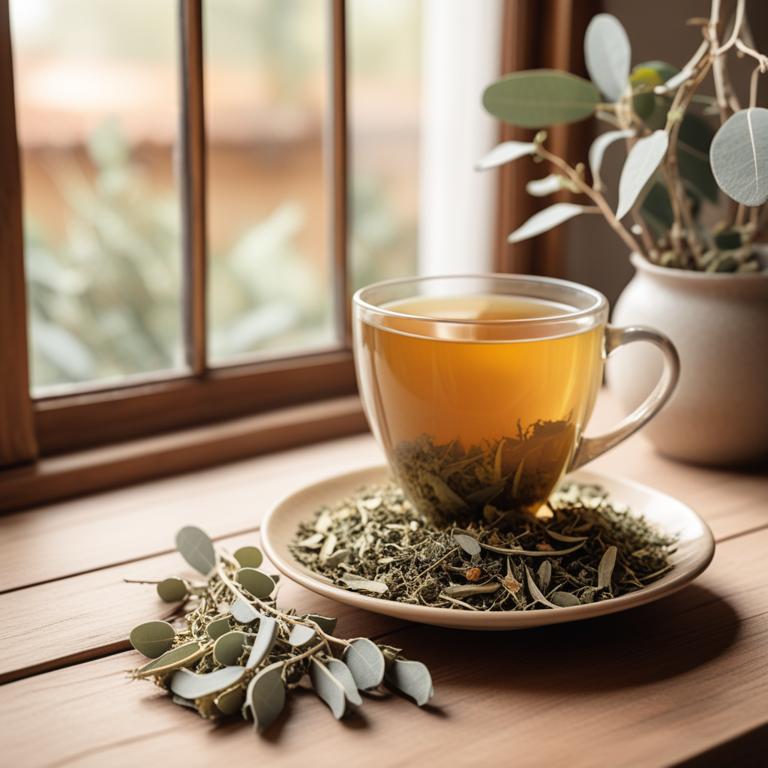
Eucalyptus globulus teas, a popular herbal preparation, have been traditionally used to treat fever due to their decongestant and anti-inflammatory properties.
The menthol content in Eucalyptus globulus teas helps to relieve fever by increasing blood flow to the skin's surface, allowing the body to cool down and recover from the fever.
The bioactive constituents, including flavonoids and phenolic acids, possess antioxidant and anti-inflammatory properties that help to reduce fever and alleviate its associated symptoms.
Drinking Eucalyptus globulus teas can provide relief from fever and its symptoms, making it a beneficial herbal remedy for those affected by this ailment.
Related Study
According to "African journal of traditional, complementary, and alternative medicines : AJTCAM", Eucalyptus globulus teas are used by traditional communities in Brazil for treating fever in children.
Recipe:
- Gather 1 cup of fresh eucalyptus leaves or 2 tablespoons of dried eucalyptus leaves.
- Heat 1 cup of water in a pot until it boils.
- Add the eucalyptus leaves to the boiling water and let it steep for 5-7 minutes.
- Strain the tea into a cup and discard the leaves.
- Drink the tea hot, 2-3 times a day, to help relieve fever.
Eucalyptus globulus teas can be used to treat fever, but it may cause side effects such as allergic reactions, stomach upset, and diarrhea due to its strong essential oil content.
When using Eucalyptus globulus teas to treat fever, precautions should be taken to avoid skin irritation and interactions with other medications, especially blood thinners, and to only consume it in moderation, ideally for short periods of time.
Eucalyptus Globulus Tea on Amazon
Jovvily Eucalyptus Leaves - 1lb - Dried - Cut & Sifted - Herbal Tea
Disclaimer: We earn a commission if you click this link and make a purchase at no additional cost to you.
2. Zingiber officinale teas

Zingiber officinale teas, also known as ginger tea, have been traditionally used to treat fever and its associated symptoms.
This herbal preparation helps to treat fever by reducing inflammation and relieving pain, as well as by promoting sweating, which helps to lower body temperature.
The bioactive constituents of ginger tea, including gingerols and shogaols, exhibit anti-inflammatory and antipyretic properties that contribute to its fever-reducing effects.
By incorporating ginger tea into their treatment regimen, individuals can benefit from its ability to alleviate fever symptoms and promote overall well-being.
Related Study
According to "Journal of ethnopharmacology", Zingiber officinale teas for fever have been found to be effective in reducing yeast-induced fever in rats.
Recipe:
- Get 1 tablespoon of dried Zingiber officinale (ginger) root.
- Boil 1 cup of water in a pot.
- Add the ginger root to the boiling water.
- Reduce heat and let it simmer for 5-7 minutes.
- Strain the tea and drink it warm, 2-3 times a day.
Zingiber officinale teas can be used to treat fever, but its use may cause side effects such as stomach upset, nausea, and dizziness due to its active compound, gingerol, which can be too potent for some individuals.
To use Zingiber officinale teas safely, take it in moderation, especially for people with sensitive stomachs, and avoid consuming it on an empty stomach to minimize the risk of stomach upset.
Zingiber Officinale Tea on Amazon
FGO Organic Ginger Tea, 100 Count, Eco-Conscious Tea Bags, Caffeine Free, Packaging May Vary (Pack of 1)
Disclaimer: We earn a commission if you click this link and make a purchase at no additional cost to you.
3. Echinacea purpurea teas

Echinacea purpurea teas have been traditionally used to treat fever and alleviate its associated symptoms due to their immune-boosting properties.
The anti-inflammatory and antiviral properties of this herbal preparation help to reduce the severity of fever and its related discomfort.
The bioactive constituents of Echinacea purpurea teas, including alkylamides, glycoproteins, and phenolic acids, contribute to its therapeutic effects by modulating the immune system and reducing inflammation.
Regular consumption of Echinacea purpurea teas can help to prevent recurring fevers and alleviate symptoms associated with the common cold and flu, providing relief and promoting overall well-being.
Related Study
According to "The Cochrane database of systematic reviews", Echinacea purpurea teas for fever may be effective as some preparations containing Echinacea extracts may be better than a placebo, although there is not enough evidence to recommend a specific product.
Recipe:
- Gather 2 teaspoons of dried Echinacea purpurea root and flowers.
- Boil 1 cup of water.
- Add the Echinacea mixture to the boiling water and let it steep for 5 minutes.
- Strain the tea into a cup and discard the solids.
- Drink 1/2 cup of the tea up to 3 times a day to help relieve fever.
Echinacea purpurea teas can cause dizziness and stomach upset in some individuals, particularly when consumed in large amounts or for extended periods, which may lead to nausea and vomiting.
To use Echinacea purpurea teas safely, it's essential to start with small doses and gradually increase as needed, avoid consuming it during pregnancy or breastfeeding, and be cautious when combining it with other medications or herbal remedies.
Echinacea Purpurea Tea on Amazon
BLUE TEA - Chamomile Tea - Butterfly Pea Flower -18 Count - Pyramid Tea Bag | DETOX TEA | Caffeine Free - Flower Based - Vegan - Non-Bitter - Natural Ingredients | Tin Packaging
Disclaimer: We earn a commission if you click this link and make a purchase at no additional cost to you.
4. Sambucus nigra teas
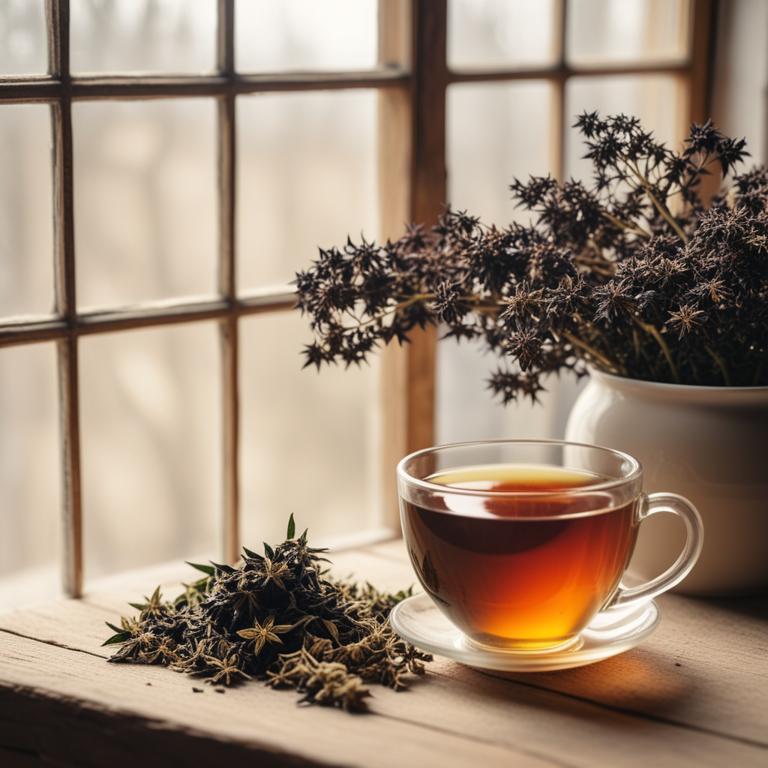
Sambucus nigra teas, also known as elderflower tea, have been traditionally used to treat fever and its associated symptoms due to their anti-inflammatory and antiviral properties.
The bioactive constituents of Sambucus nigra, including flavonoids, phenolic acids, and sambunigrin, help to reduce fever and alleviate congestion by inhibiting the production of pro-inflammatory cytokines and promoting the clearance of viral particles from the respiratory tract.
The benefits of Sambucus nigra teas in treating fever include their ability to soothe a sore throat, relieve headache and body aches, and promote a restful night's sleep.
Additionally, Sambucus nigra teas have been shown to be effective in reducing the severity and duration of fever in children and adults, making them a popular natural remedy for this common ailment.
Related Study
According to "Journal of ethnopharmacology", Sambucus nigra teas are used in Unani (Greco-Arab) medicine as a sweetened decoction for the treatment of associated fevers.
Recipe:
- Gather 2 tablespoons of dried Sambucus nigra flowers.
- Combine 2 tablespoons of dried flowers with 1 cup of boiling water in a cup.
- Let the mixture steep for 5-7 minutes.
- Strain the liquid and discard the solids.
- Drink the tea 2-3 times a day to help relieve fever symptoms.
Sambucus nigra teas can be effective in treating fever, but possible side effects may include allergic reactions, stomach upset, and interactions with other medications.
To use Sambucus nigra teas safely, avoid taking them if you are pregnant or breastfeeding, and do not consume excessive amounts, as this may lead to nausea, dizziness, and other adverse effects.
Sambucus Nigra Tea on Amazon
Elderberry Turmeric Ginger Tea - Made in USA
Disclaimer: We earn a commission if you click this link and make a purchase at no additional cost to you.
5. Ginkgo biloba teas
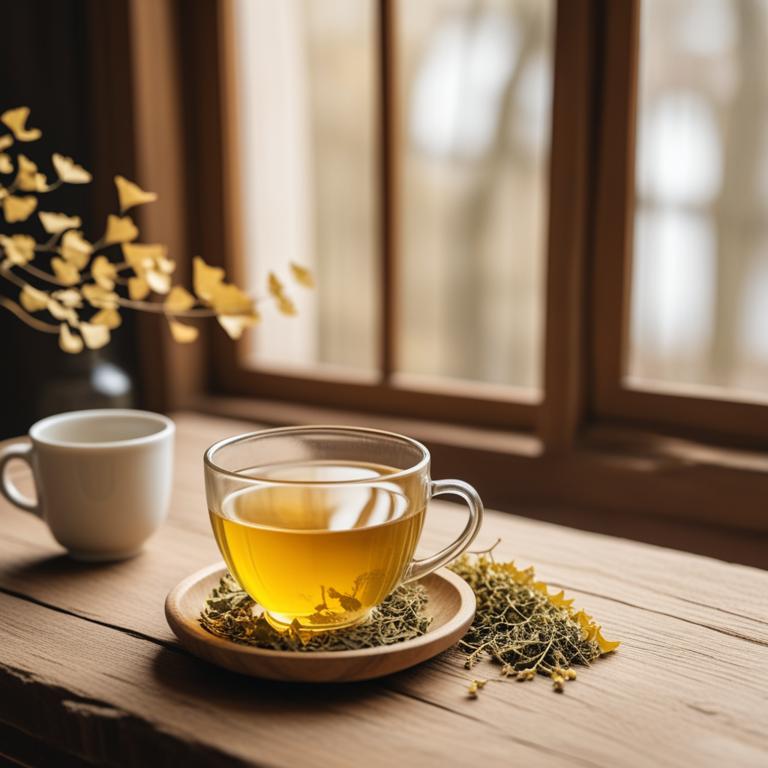
Ginkgo biloba teas have been traditionally used to treat fever-related ailments due to their anti-inflammatory, antioxidant, and antipyretic properties.
The bioactive constituents, such as flavonoids, bilobalide, and ginkgolides, in Ginkgo biloba teas help to reduce fever by inhibiting the production of pro-inflammatory cytokines and promoting the breakdown of fever-inducing toxins in the body.
By consuming Ginkgo biloba teas, individuals can benefit from reduced fever, alleviated body aches, and improved overall well-being.
The antioxidant properties of Ginkgo biloba teas also help to protect the body from oxidative stress and cell damage caused by fever.
Recipe:
- Gather 1 cup of fresh water and 1 teaspoon of dried Ginkgo biloba leaves.
- Heat the water in a pot until it boils.
- Add the Ginkgo biloba leaves to the boiling water and let it steep for 5-7 minutes.
- Strain the tea into a cup and discard the leaves.
- Drink the tea while it's still warm, up to 3 times a day for relief from fever.
Ginkgo biloba teas can be an effective treatment for fever ailments, but possible side effects may include dizziness, stomach upset, and allergic reactions such as skin rashes or itching.
Precautions to take when using Ginkgo biloba teas include monitoring blood pressure, as it may increase blood pressure levels, and avoiding consumption if you have any allergies or are taking medications that may interact with the herbal preparation.
Ginkgo Biloba Tea on Amazon
Tai Chi Think Sharp Energizing Tea (Ginseng Ginkgo Biloba) 12 Bags
Disclaimer: We earn a commission if you click this link and make a purchase at no additional cost to you.
6. Glycyrrhiza glabra teas
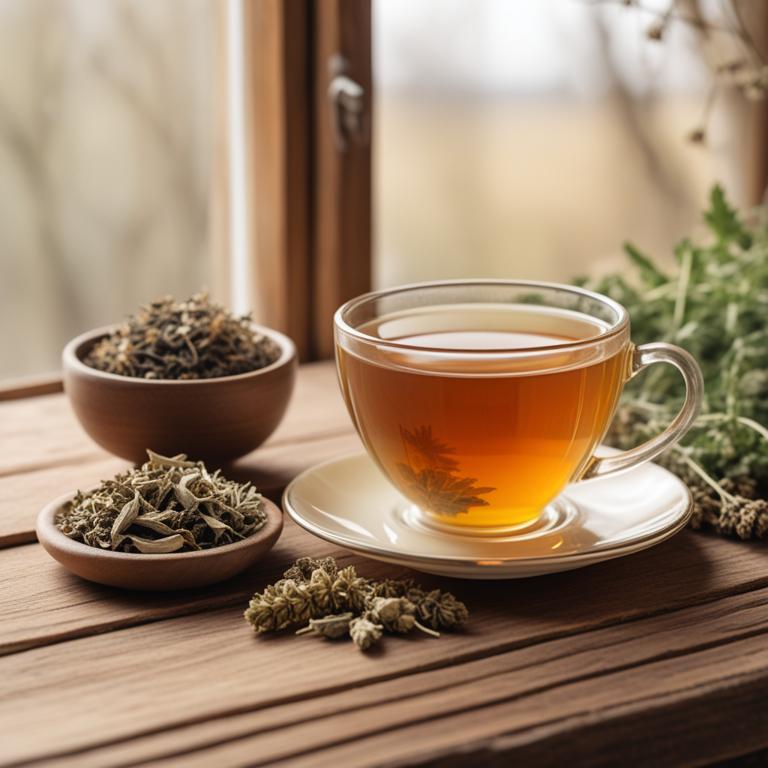
Glycyrrhiza glabra teas, also known as licorice root tea, have been used for centuries to treat fever and other ailments due to their anti-inflammatory, antiviral, and antipyretic properties.
The bioactive constituents present in Glycyrrhiza glabra, such as glycyrrhizin and flavonoids, help to reduce fever by inhibiting the production of pro-inflammatory cytokines and inducing the production of anti-inflammatory cytokines.
The consumption of Glycyrrhiza glabra teas has been shown to provide relief from fever by reducing body temperature, alleviating symptoms, and promoting overall well-being.
The benefits of using Glycyrrhiza glabra teas to treat fever include its safety, efficacy, and the ability to be used in conjunction with other treatments, making it a valuable natural remedy for this common ailment.
Related Study
According to "Mini reviews in medicinal chemistry", Glycyrrhiza glabra teas for fever may help modulate the immune system, inhibit virus growth, produce anti-inflammatory activity, and inactivate viruses.
Recipe:
- Gather 1 teaspoon of dried Glycyrrhiza glabra root and 1 cup of boiling water.
- Steep the root in the boiling water for 5-7 minutes.
- Strain the mixture into a cup to remove the root.
- Add 1 tablespoon of honey to the tea, if desired, to make it sweeter.
- Drink the tea 2-3 times a day to help relieve fever symptoms.
Glycyrrhiza glabra teas can be used to treat fever, but possible side effects may include high blood pressure, low potassium levels, and an increased risk of heart problems, particularly in individuals with pre-existing conditions.
Precautions should be taken when using these teas, such as consuming them in moderation and limiting use to short periods, to minimize the risk of adverse reactions.
Glycyrrhiza Glabra Tea on Amazon
Pukka Herbal Teas Licorice and Cinnamon - 20 Bags, 20 Count
Disclaimer: We earn a commission if you click this link and make a purchase at no additional cost to you.
7. Achillea millefolium teas
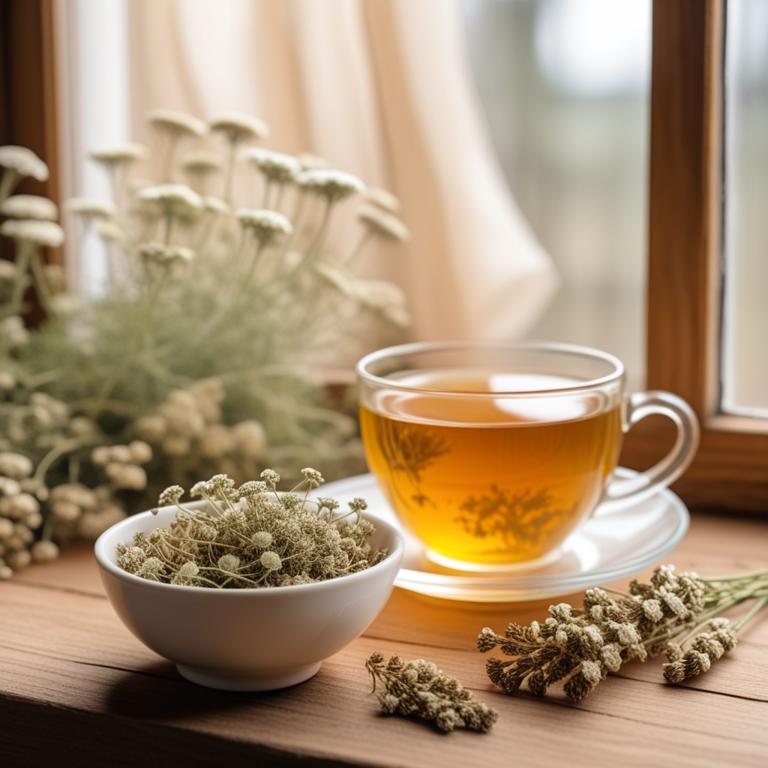
Achillea millefolium teas, also known as yarrow tea, have been traditionally used to treat fever and various other ailments due to their anti-inflammatory and antipyretic properties.
The bioactive constituents of this herbal preparation, including flavonoids, sesquiterpenes, and phenolic acids, help to reduce fever by promoting sweating and dilating blood vessels, thereby facilitating the elimination of heat from the body.
The benefits of this herbal preparation in treating fever include its ability to relieve symptoms such as sweating, chills, and body aches, making it a natural and effective remedy for this common condition.
Furthermore, the anti-inflammatory properties of Achillea millefolium teas also help to reduce the risk of complications associated with fever, such as inflammation and infection.
Related Study
According to "Pakistan journal of pharmaceutical sciences", Achillea millefolium teas for fever showed a significant antipyretic potential in yeast-induced elevated temperature, with a dose of 500mg/kg being as effective as the standard drug paracetamol in decreasing yeast-induced pyrexia.
Recipe:
- Gather 1 cup of fresh or dried Achillea millefolium leaves.
- Measure 1 tablespoon of the leaves and place them in a heat-resistant cup.
- Pour 1 cup of boiling water over the leaves and let it steep for 5-7 minutes.
- Strain the liquid through a fine-mesh sieve into another cup to remove the leaves.
- Drink the tea 2-3 times a day as needed for fever relief.
Achillea millefolium teas can be used to treat fever, but it may cause side effects such as dizziness, nausea, and stomach upset in some individuals.
Precautions should be taken when using this herbal preparation, including avoiding it if you have allergies, taking it in moderation and for a limited period, and being cautious when using it with other medications or substances that slow down the heart rate.
Achillea Millefolium Tea on Amazon
Biokoma Pure and Organic Yarrow Dried Herb 30 Tea Bags 1.5oz In Resealable Moisture Proof Pouch, USDA Certified Organic - Herbal Tea, No Additives, No Preservatives, No GMO, Kosher
Disclaimer: We earn a commission if you click this link and make a purchase at no additional cost to you.
8. Cinchona officinalis teas
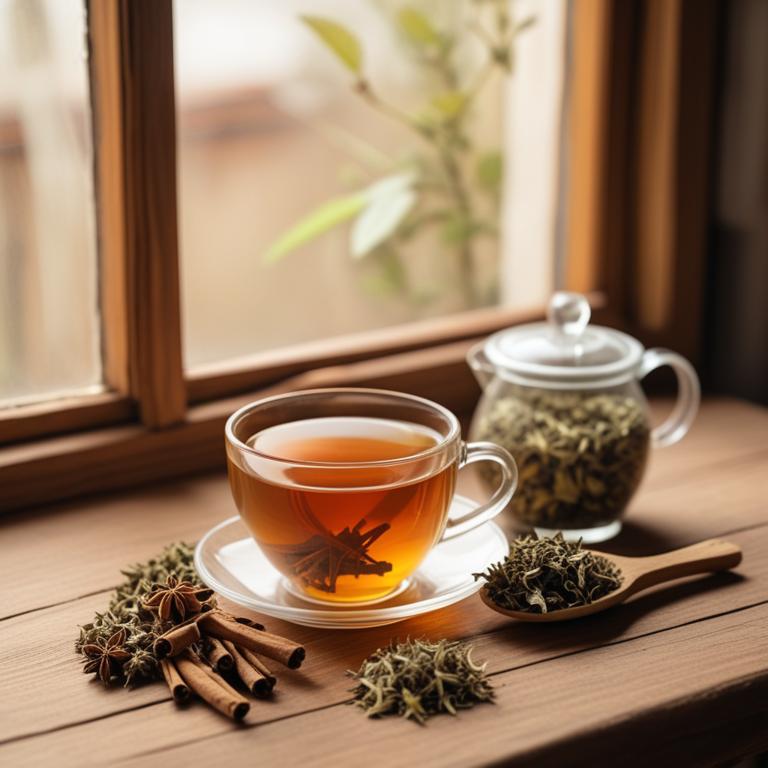
Cinchona officinalis teas have been used for centuries to treat the fever ailment due to their properties of reducing inflammation and alleviating symptoms.
This herbal preparation helps to treat the ailment by promoting sweating, which cools the body and brings down the fever, as well as by acting on the nervous system to reduce agitation and discomfort.
The bioactive constituents of Cinchona officinalis teas, including quinine, quinidine, and tannins, contribute to their therapeutic effects by exhibiting anti-inflammatory, antimicrobial, and antipyretic properties.
The benefits of using Cinchona officinalis teas to treat the fever ailment include their natural origin, low risk of side effects, and ability to provide rapid relief from symptoms, making them a popular choice among herbalists and natural health practitioners.
Recipe:
- Gather 2 teaspoons of dried Cinchona officinalis bark and a cup of boiling water.
- Add the dried Cinchona bark to the boiling water and let it steep for 5-7 minutes.
- Strain the tea into a cup using a fine-mesh sieve or cheesecloth.
- Add honey or lemon to taste, if desired, and stir well.
- Drink the tea 2-3 times a day to help reduce fever, but consult a doctor for proper diagnosis and treatment.
Cinchona officinalis teas can cause stomach upset, nausea, and diarrhea in some individuals due to its high quinine content, which may lead to gastrointestinal side effects.
To minimize potential side effects, it is recommended to start with low doses and gradually increase the amount, avoid taking the tea on an empty stomach, and be cautious of interactions with other medications, such as blood thinners and certain antibiotics.
Cinchona Officinalis Tea on Amazon
Quina Roja(chinona) & Palo de Víbora Tea – 100% Natural, Vegan, Hecho en México | 25 Tea Bags
Disclaimer: We earn a commission if you click this link and make a purchase at no additional cost to you.
9. Lavandula angustifolia teas
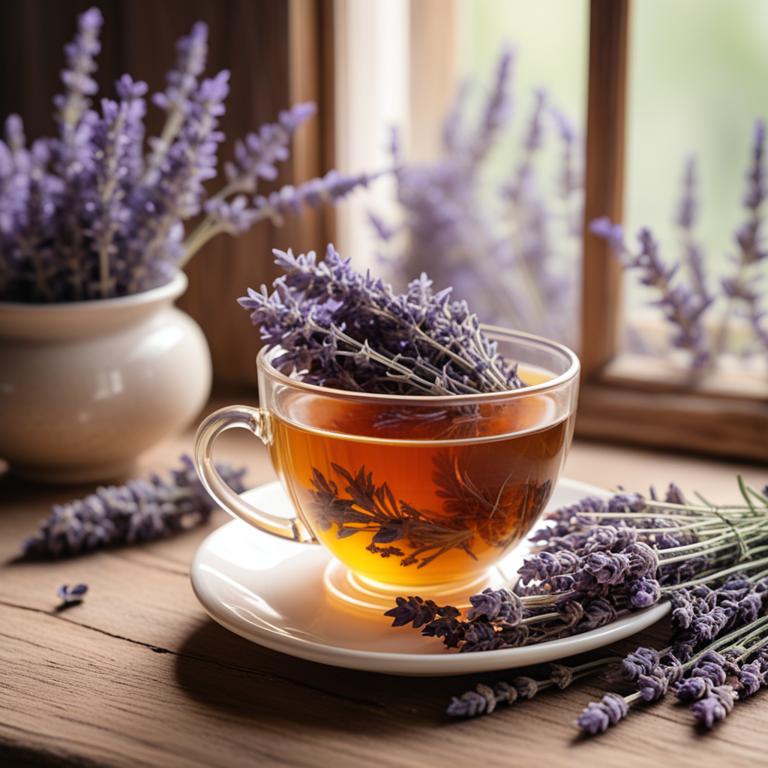
Lavandula angustifolia teas, also known as lavender tea, have been traditionally used to treat fever due to their anti-inflammatory, antiseptic, and antispasmodic properties.
The bioactive constituents present in this herbal preparation, such as linalool and linalyl acetate, help to reduce fever by promoting sweating and relieving heat in the body.
By reducing inflammation and promoting relaxation, lavender tea can help to alleviate symptoms of fever, providing relief from discomfort and promoting a restful sleep.
The benefits of using lavender tea to treat fever include its soothing and calming effects, which can help to reduce stress and promote overall well-being.
Recipe:
- Gather 1 cup of dried Lavandula angustifolia flowers. You can buy them at a health food store or online.
- Heat 1 cup of water in a pot. Bring it to a boil.
- Add 2-3 tablespoons of dried Lavandula angustifolia flowers to the boiling water. Remove from heat.
- Let the mixture steep for 5-7 minutes. Strain the flowers with a fine-mesh sieve or cheesecloth.
- Drink 1/2 cup of the tea, 2-3 times a day, to help reduce fever. Store any leftover tea in the fridge for up to 24 hours.
Lavandula angustifolia teas can be used to treat fever, but possible side effects may include dizziness, nausea, and allergic reactions such as skin irritation or respiratory problems.
Precautions should be taken, such as starting with a small dose, avoiding use in individuals with sensitive stomachs, and keeping the teas away from children and pets.
Lavandula Angustifolia Tea on Amazon
Tiesta Tea - Lavender Chamomile Herbal Tea | Loose Leaf | Calming Blend with Chamomile and Lavender | Caffeine-Free Herbal | Great for Hot or Iced Brews | Resealable Bulk Pouch, 200 Cups | 8 Ounce
Disclaimer: We earn a commission if you click this link and make a purchase at no additional cost to you.
10. Echinacea angustifolia teas
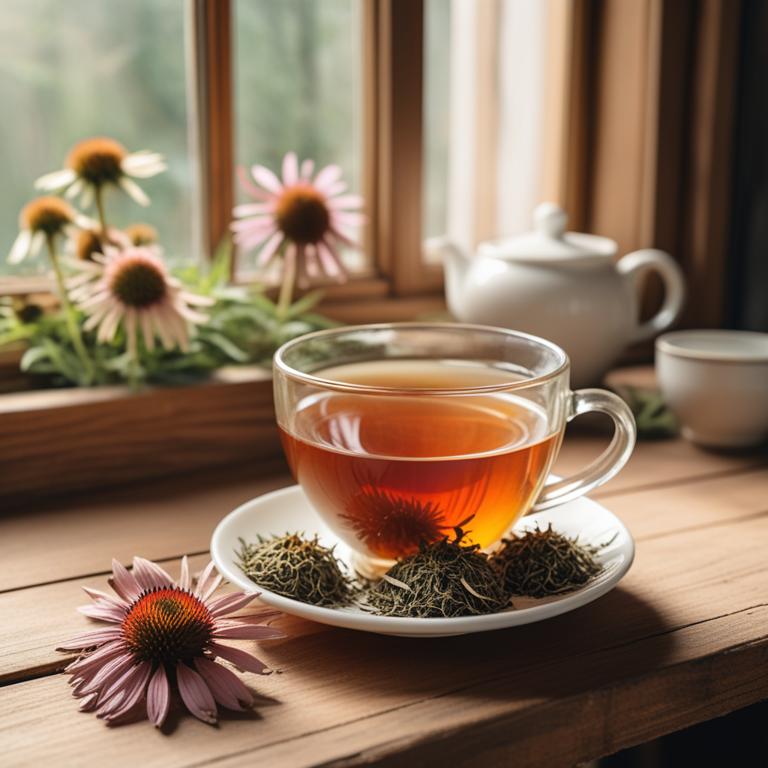
Echinacea angustifolia teas have been traditionally used to treat fever and other related ailments due to their anti-inflammatory, antiviral, and immunomodulatory properties.
The herbal preparation helps to treat fever by reducing inflammation, modulating the immune system, and alleviating symptoms such as body aches and headaches.
The bioactive constituents of Echinacea angustifolia teas, including alkylamides, caffeic acid derivatives, and polyphenols, are responsible for their therapeutic effects and help to mitigate the severity of fever.
The benefits of using Echinacea angustifolia teas to treat fever include reduced recovery time, alleviated symptoms, and a boost to the immune system.
Related Study
According to "The Cochrane database of systematic reviews", Echinacea angustifolia teas for fever may be effective compared to a placebo, but there is not enough evidence to recommend their use for the treatment or prevention of common colds.
Recipe:
- Gather 2 tablespoons of dried Echinacea angustifolia root.
- Place the root in a cup of boiling water.
- Let it steep for 5-7 minutes to release the active ingredients.
- Strain the liquid and discard the root.
- Drink the tea warm or at room temperature, 2-3 times a day, for fever relief.
Echinacea angustifolia teas can be beneficial in treating fever, but possible side effects include stomach upset, nausea, and allergic reactions in some individuals.
Precautions to take when using these teas include monitoring your body's reaction and adjusting the dosage accordingly, as well as avoiding consumption if you have sensitive stomach or allergies.
11. Rosmarinus officinalis teas
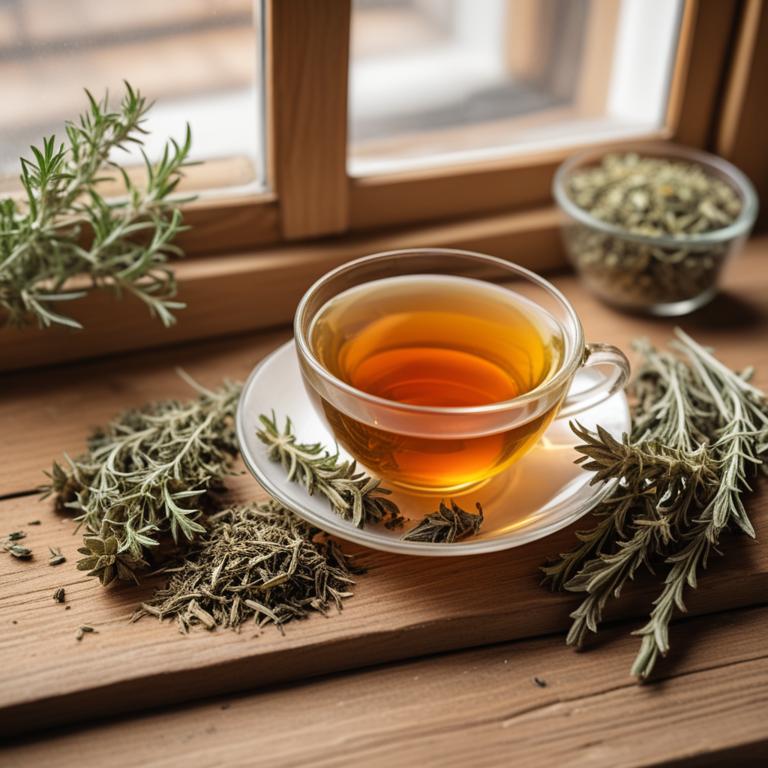
Rosmarinus officinalis teas have been traditionally used to treat fever, leveraging their anti-inflammatory and antipyretic properties to help alleviate symptoms.
The herbal preparation's ability to stimulate sweating and promote heat loss helps to lower body temperature and alleviate discomfort.
Rosmarinus officinalis teas contain bioactive constituents such as carnosic acid and rosmarinic acid, which exhibit antioxidant and anti-inflammatory activities that contribute to their fever-reducing effects.
The benefits of using Rosmarinus officinalis teas to treat fever include their natural and non-invasive approach, minimal side effects, and potential for long-term immune system support.
Recipe:
- Gather 1 cup of fresh Rosmarinus officinalis leaves and 1 cup of boiling water.
- Add 2 tablespoons of honey (optional) to a teapot.
- Pour the boiling water over the Rosmarinus officinalis leaves in the teapot.
- Steep the mixture for 5-7 minutes, then strain the liquid.
- Drink the tea in small amounts, up to 3 times a day, when needed for fever relief.
Rosmarinus officinalis teas can be used to treat fever, but its possible side effects may include gastrointestinal upset, dizziness, and allergic reactions in some individuals.
Precautions should be taken to avoid consuming excessive amounts, as this may lead to interactions with certain medications or exacerbate conditions such as high blood pressure and pregnancy.
Rosmarinus Officinalis Tea on Amazon
Palm Beach Medicinal Herbs - Rosemary Tea - Pure Herbal Tea Series, 30ct
Disclaimer: We earn a commission if you click this link and make a purchase at no additional cost to you.
12. Salvia officinalis teas
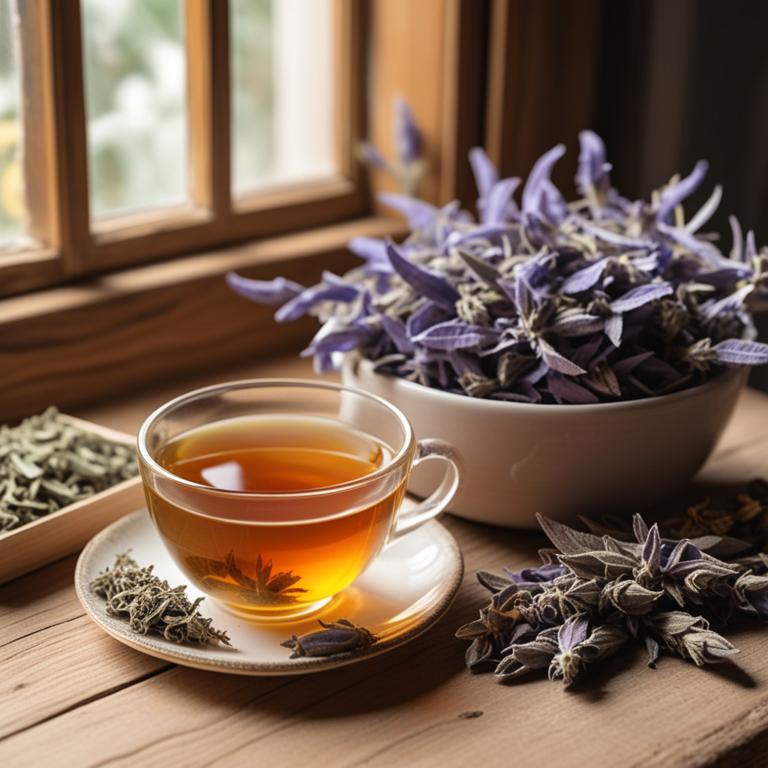
Salvia officinalis teas have been traditionally used to treat fever, a common ailment characterized by elevated body temperature, due to their antipyretic properties.
The herbal preparation helps to treat fever by reducing inflammation and promoting sweating, which aids in the elimination of toxins from the body.
The bioactive constituents of Salvia officinalis teas, including rosmarinic acid, apigenin, and luteolin, possess anti-inflammatory and antioxidant properties that contribute to their therapeutic effects.
The benefits of Salvia officinalis teas in treating fever include reduced discomfort, improved sleep quality, and a faster recovery time, making them a popular herbal remedy for this common ailment.
Recipe:
- Gather 1 cup of fresh Salvia officinalis leaves and 1 cup of boiling water.
- Steep the leaves in the boiling water for 5-7 minutes, then strain.
- Add 1 tablespoon of honey (optional) to the tea for taste.
- Drink 1 cup of the tea, 3-4 times a day, as needed for fever relief.
- Consult a doctor before using Salvia officinalis tea, especially for children, pregnant women, or people with allergies.
Salvia officinalis teas can be used to treat fever, but it may cause side effects such as stomach upset, dizziness, and allergic reactions in some individuals.
Precautions should be taken when using Salvia officinalis teas to treat fever, including consuming the tea in moderation, avoiding it if pregnant or breastfeeding, and being aware of potential interactions with other medications.
Salvia Officinalis Tea on Amazon
Organic India Tulsi Sweet Rose Herbal Tea - Holy Basil Leaf, African Basil, Chamomilie, Lemon Myrtle, Stress Relieving, Immune Support, USDA Certified Organic, Caffeine-Free - 18 Infusion Bags, 6 Pack
Disclaimer: We earn a commission if you click this link and make a purchase at no additional cost to you.
13. Thymus vulgaris teas
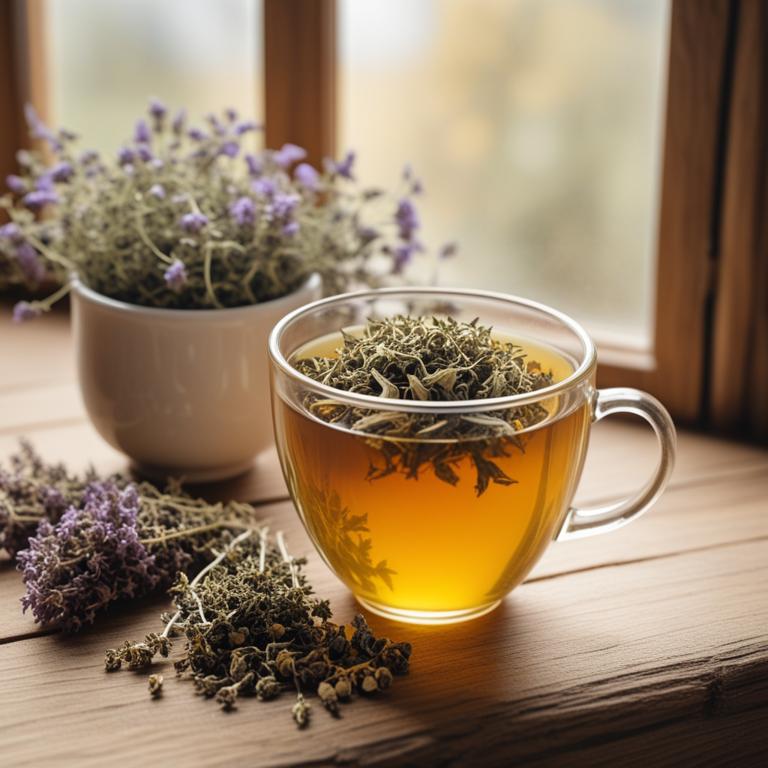
Thymus vulgaris teas, also known as thyme tea, have been traditionally used to treat fever due to its antipyretic and anti-inflammatory properties.
The bioactive constituents present in thyme tea, such as thymol and carvacrol, exhibit antimicrobial and antioxidant activities that help to reduce the severity of fever and alleviate associated symptoms.
The herbal preparation helps to treat fever by inducing sweating, promoting the elimination of toxins from the body, and modulating the immune system.
The benefits of using thymus vulgaris teas to treat fever include reducing the duration of the illness, alleviating symptoms such as headaches and body aches, and promoting overall well-being.
Related Study
According to "Wiadomosci lekarskie (Warsaw, Poland : 1960)", Thymus vulgaris teas for fever may be beneficial in alleviating cough and dyspnea due to its spasmolytic, antimicrobial, anti-inflammatory, and immunomodulatory properties.
Recipe:
- Gather 1 cup of fresh Thymus vulgaris leaves and flowers.
- Crush the leaves and flowers to release their oils.
- Steep 1 tablespoon of crushed Thymus vulgaris in 1 cup of boiling water for 5-7 minutes.
- Strain the tea and discard the solids.
- Drink 1/2 cup of the tea every 2-3 hours to help reduce fever.
Thymus vulgaris teas can be effective in treating fever, but it may also cause side effects such as digestive issues, allergic reactions, and interactions with certain medications, including blood thinners and diabetes medications.
Precautions to take when using Thymus vulgaris teas include avoiding excessive consumption, especially for pregnant or breastfeeding women, and monitoring blood pressure in individuals with hypertension, as it may cause blood pressure fluctuations.
Thymus Vulgaris Tea on Amazon
Buddha Teas Organic Thyme Leaf Tea - OU Kosher, USDA Organic, CCOF Organic, 18 Bleach-Free Tea Bags
Disclaimer: We earn a commission if you click this link and make a purchase at no additional cost to you.